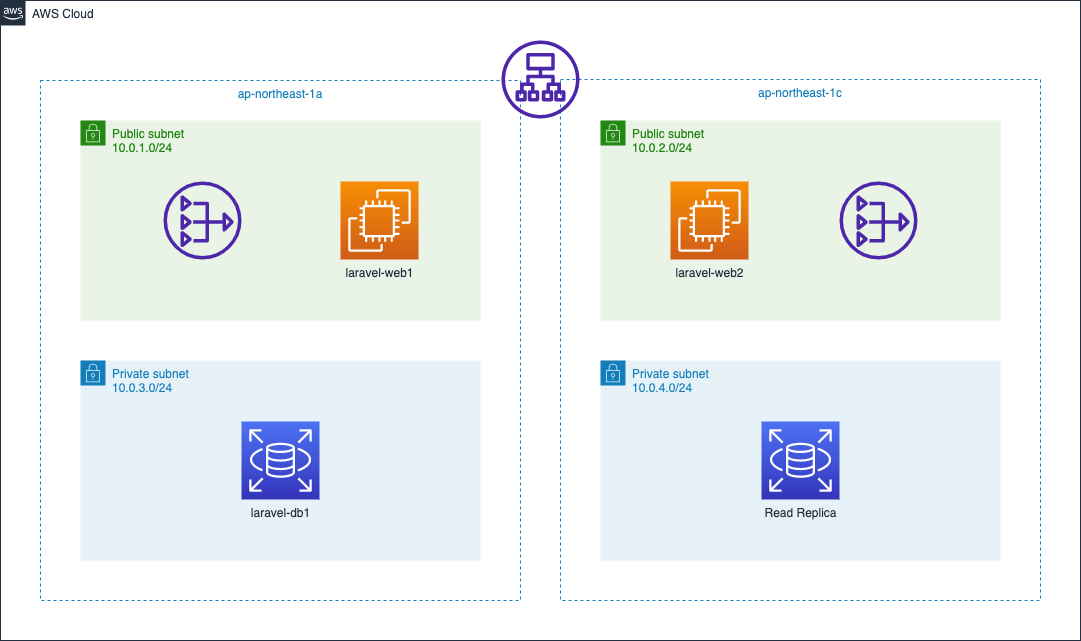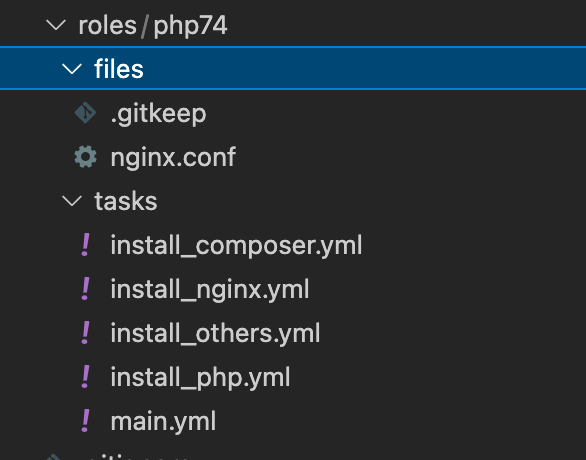CloudFormationとAnsibleでALB+EC2+RDSのLaravel環境を構築する(解説編)
検証用に php/Laravel のアプリケーションを AWS へ素早くデプロイしたかったので、CFn と Ansible を使って爆速で ALB+EC2+RDS の環境を作れるようにしました。
手順編はこちら
リポジトリはこちら
動作環境
- macOS Monterey 12.1(Intel)
全体の構成
構成はこんな感じ

ディレクトリは以下のようになっています。
project-root/
- docs/ # ドキュメントの格納場所
- CFn/ # Cloud Formationのテンプレート
- ansible/ # Ansibleの定義
- docker/ # ローカル実行用のdocker定義
- src/ # Laravelアプリケーションのソース
- LICENSE
- docker-compose.yml
- Makefile # docker composeコマンドを楽に使うためのMakefile
- README.md
プロジェクトルートのdocker-compose.ymlとMakefileは Laravel の実行環境を立ち上げるためのものです。
Laravel のアプリケーションはsrc下にあり、CFn下は Cloud Formation による AWS 側の定義があり、ansibleの下は Ansible での EC2 の設定が記載されています。
本記事ではCloud FormationについてとAnsibleについて解説します。
Cloud Formation
Cloud Formation のテンプレートは、今回network.ymlとapplication.ymlに分けています。
network.yml
VPC/Subnet/Security Group/Routing の設定を行い、application.ymlで必要になる値をOutputsで出力しています。
基本的な書き方は公式ドキュメントを見ていただくのが良いと思いますが、
特筆すべきは、各サブネットで宣言している Cidr を!Select [1, !Cidr [!GetAtt LaravelVPCfromCFn.CidrBlock, 2, 8]]のような書き方をすることによって、
VPC で宣言したCidrから自動的に分割して割り振ってくれるように記載したところです。
参考:[小ネタ]「!Cidr」というチョット便利な CloudFormation の組み込み関数 | DevelopersIO
AWSTemplateFormatVersion: 2010-09-09
Resources:
# ------------------------------------------------------------#
# VPC
# ------------------------------------------------------------#
LaravelVPCfromCFn:
Type: AWS::EC2::VPC
Properties:
CidrBlock: 10.0.0.0/21
EnableDnsSupport: true
Tags:
- Key: Name
Value: LaravelVPCfromCFn
LaravelInternetGateway:
Type: AWS::EC2::InternetGateway
Properties:
Tags:
- Key: Name
Value: LaravelInternetGateway
LaravelAttachGateway:
Type: AWS::EC2::VPCGatewayAttachment
Properties:
VpcId: !Ref LaravelVPCfromCFn
InternetGatewayId: !Ref LaravelInternetGateway
# ------------------------------------------------------------#
# Subnet
# ------------------------------------------------------------#
LaravelWeb1Subnet:
Type: AWS::EC2::Subnet
Properties:
AvailabilityZone: "ap-northeast-1a"
VpcId: !Ref LaravelVPCfromCFn
CidrBlock: !Select [1, !Cidr [!GetAtt LaravelVPCfromCFn.CidrBlock, 2, 8]]
Tags:
- Key: Name
Value: LaravelWeb1Subnet
LaravelWeb2Subnet:
Type: AWS::EC2::Subnet
Properties:
AvailabilityZone: "ap-northeast-1c"
VpcId: !Ref LaravelVPCfromCFn
CidrBlock: !Select [2, !Cidr [!GetAtt LaravelVPCfromCFn.CidrBlock, 3, 8]]
Tags:
- Key: Name
Value: LaravelWeb2Subnet
LaravelRDS1Subnet:
Type: AWS::EC2::Subnet
Properties:
AvailabilityZone: "ap-northeast-1a"
VpcId: !Ref LaravelVPCfromCFn
CidrBlock: !Select [3, !Cidr [!GetAtt LaravelVPCfromCFn.CidrBlock, 4, 8]]
Tags:
- Key: Name
Value: LaravelRDS1Subnet
LaravelRDS2Subnet:
Type: AWS::EC2::Subnet
Properties:
AvailabilityZone: "ap-northeast-1c"
VpcId: !Ref LaravelVPCfromCFn
CidrBlock: !Select [4, !Cidr [!GetAtt LaravelVPCfromCFn.CidrBlock, 5, 8]]
Tags:
- Key: Name
Value: LaravelRDS2Subnet
# ------------------------------------------------------------#
# SecurityGroup
# ------------------------------------------------------------#
LaravelALBSG:
Type: AWS::EC2::SecurityGroup
Properties:
GroupName: LaravelALBSG
GroupDescription: LaravelALBSG-Description
VpcId: !Ref LaravelVPCfromCFn
SecurityGroupIngress:
- IpProtocol: tcp
FromPort: 80
ToPort: 80
CidrIp: 0.0.0.0/0
- IpProtocol: tcp
FromPort: 443
ToPort: 443
CidrIp: 0.0.0.0/0
Tags:
- Key: Name
Value: LaravelALBSG
LaravelWebSG:
Type: AWS::EC2::SecurityGroup
Properties:
GroupName: LaravelWebSG
GroupDescription: LaravelWebSG-Description
VpcId: !Ref LaravelVPCfromCFn
SecurityGroupIngress:
- IpProtocol: tcp
FromPort: 22
ToPort: 22
CidrIp: 0.0.0.0/0
- IpProtocol: tcp
FromPort: 80
ToPort: 80
CidrIp: 0.0.0.0/0
Tags:
- Key: Name
Value: LaravelWebSG
LaravelRDSSG:
Type: AWS::EC2::SecurityGroup
Properties:
GroupName: LaravelRDSSG
GroupDescription: LaravelRDSSG-Description
VpcId: !Ref LaravelVPCfromCFn
SecurityGroupIngress:
- IpProtocol: tcp
FromPort: 3306
ToPort: 3306
CidrIp: !Select [1, !Cidr [!GetAtt LaravelVPCfromCFn.CidrBlock, 2, 8]]
- IpProtocol: tcp
FromPort: 3306
ToPort: 3306
CidrIp: !Select [2, !Cidr [!GetAtt LaravelVPCfromCFn.CidrBlock, 3, 8]]
Tags:
- Key: Name
Value: LaravelRDSSG
# ------------------------------------------------------------#
# RouteTable
# ------------------------------------------------------------#
LaravelWeb1SubnetRouteTable:
Type: "AWS::EC2::RouteTable"
Properties:
VpcId: !Ref LaravelVPCfromCFn
Tags:
- Key: Name
Value: LaravelWeb1SubnetRouteTable
LaravelWeb2SubnetRouteTable:
Type: "AWS::EC2::RouteTable"
Properties:
VpcId: !Ref LaravelVPCfromCFn
Tags:
- Key: Name
Value: LaravelWeb2SubnetRouteTable
# ------------------------------------------------------------#
# Routing
# ------------------------------------------------------------#
LaravelWeb1SubnetRoute:
Type: "AWS::EC2::Route"
Properties:
RouteTableId: !Ref LaravelWeb1SubnetRouteTable
DestinationCidrBlock: "0.0.0.0/0"
GatewayId: !Ref LaravelInternetGateway
LaravelWeb2SubnetRoute:
Type: "AWS::EC2::Route"
Properties:
RouteTableId: !Ref LaravelWeb2SubnetRouteTable
DestinationCidrBlock: "0.0.0.0/0"
GatewayId: !Ref LaravelInternetGateway
# ------------------------------------------------------------#
# RouteTable Associate
# ------------------------------------------------------------#
LaravelWeb1SubnetRouteAssociation:
Type: "AWS::EC2::SubnetRouteTableAssociation"
Properties:
SubnetId: !Ref LaravelWeb1Subnet
RouteTableId: !Ref LaravelWeb1SubnetRouteTable
LaravelWeb2SubnetRouteAssociation:
Type: "AWS::EC2::SubnetRouteTableAssociation"
Properties:
SubnetId: !Ref LaravelWeb2Subnet
RouteTableId: !Ref LaravelWeb2SubnetRouteTable
Outputs:
LaravelVPCfromCFn:
Value: !Ref LaravelVPCfromCFn
Export:
Name: LaravelVPC
LaravelWeb1Subnet:
Value: !Ref LaravelWeb1Subnet
Export:
Name: LaravelWeb1Subnet
LaravelWeb2Subnet:
Value: !Ref LaravelWeb2Subnet
Export:
Name: LaravelWeb2Subnet
LaravelRDS1Subnet:
Value: !Ref LaravelRDS1Subnet
Export:
Name: LaravelRDS1Subnet
LaravelRDS2Subnet:
Value: !Ref LaravelRDS2Subnet
Export:
Name: LaravelRDS2Subnet
LaravelALBSG:
Value: !Ref LaravelALBSG
Export:
Name: Laravel-ALB-SG
LaravelWebSG:
Value: !Ref LaravelWebSG
Export:
Name: Laravel-Web-SG
LaravelRDSSG:
Value: !Ref LaravelRDSSG
Export:
Name: Laravel-RDS-SG
application.yml
次にapplication.ymlですが、こちらでは ALB/Target Group/EC2/RDS の定義を宣言しています。
基本的にnetwork.yml側で出力した値を使いつつ、EC2(Amazon Linux 2)2 台構成、RDS(MySQL)のよくある構成が作成できるようになっています。
Cloud Formation の時点では php 要素は一つもないので、別にJava用でもGo用でもRuby用でもPython用でもなんでも使い回せるかと思います。
流用するときはキーペアをご自身が用意しているものに書き換えてお使いください。
AWSTemplateFormatVersion: 2010-09-09
Resources:
# ------------------------------------------------------------#
# TargetGroup
# ------------------------------------------------------------#
LaravelTargetGroup:
Type: "AWS::ElasticLoadBalancingV2::TargetGroup"
Properties:
VpcId: !ImportValue LaravelVPC
Name: LaravelTargetGroup
Protocol: HTTP
Port: 80
HealthCheckProtocol: HTTP
HealthCheckPath: "/"
HealthCheckPort: "traffic-port"
HealthyThresholdCount: 2
UnhealthyThresholdCount: 2
HealthCheckTimeoutSeconds: 5
HealthCheckIntervalSeconds: 10
Matcher:
HttpCode: 200
Tags:
- Key: Name
Value: LaravelTargetGroup
TargetGroupAttributes:
- Key: "deregistration_delay.timeout_seconds"
Value: 300
- Key: "stickiness.enabled"
Value: false
- Key: "stickiness.type"
Value: lb_cookie
- Key: "stickiness.lb_cookie.duration_seconds"
Value: 86400
Targets:
- Id: !Ref LaravelWeb1
Port: 80
- Id: !Ref LaravelWeb2
Port: 80
# ------------------------------------------------------------#
# Internet ALB
# ------------------------------------------------------------#
LaravelALB:
Type: "AWS::ElasticLoadBalancingV2::LoadBalancer"
Properties:
Name: LaravelALB
Tags:
- Key: Name
Value: LaravelALB
Scheme: "internet-facing"
LoadBalancerAttributes:
- Key: "deletion_protection.enabled"
Value: false
- Key: "idle_timeout.timeout_seconds"
Value: 60
SecurityGroups:
- !ImportValue Laravel-ALB-SG
Subnets:
- !ImportValue LaravelWeb1Subnet
- !ImportValue LaravelWeb2Subnet
ALBListener:
Type: "AWS::ElasticLoadBalancingV2::Listener"
Properties:
DefaultActions:
- TargetGroupArn: !Ref LaravelTargetGroup
Type: forward
LoadBalancerArn: !Ref LaravelALB
Port: 80
Protocol: HTTP
# ------------------------------------------------------------#
# EC2
# ------------------------------------------------------------#
LaravelWeb1:
Type: AWS::EC2::Instance
Properties:
KeyName: MyKeypair
ImageId: ami-0218d08a1f9dac831
InstanceType: t2.micro
Monitoring: false
NetworkInterfaces:
- AssociatePublicIpAddress: true
DeviceIndex: 0
SubnetId: !ImportValue LaravelWeb1Subnet
GroupSet:
- !ImportValue Laravel-Web-SG
Tags:
- Key: Name
Value: LaravelWeb1
LaravelWeb2:
Type: AWS::EC2::Instance
Properties:
KeyName: MyKeypair
ImageId: ami-0218d08a1f9dac831
InstanceType: t2.micro
Monitoring: false
NetworkInterfaces:
- AssociatePublicIpAddress: true
DeviceIndex: 0
SubnetId: !ImportValue LaravelWeb2Subnet
GroupSet:
- !ImportValue Laravel-Web-SG
Tags:
- Key: Name
Value: LaravelWeb2
# ------------------------------------------------------------#
# RDS
# ------------------------------------------------------------#
LaravelRDSSecret:
Type: AWS::SecretsManager::Secret
Properties:
Description: LaravelRDSSecret
GenerateSecretString:
SecretStringTemplate: '{"username": "root"}'
GenerateStringKey: "password"
PasswordLength: 16
ExcludeCharacters: '"@/\'
LaravelRDS:
Type: AWS::RDS::DBInstance
Properties:
DBInstanceIdentifier: LaravelRDS
Engine: mysql
EngineVersion: 5.7
DBInstanceClass: db.t2.micro
StorageType: gp2
AllocatedStorage: 10
MasterUsername: !Sub "{{resolve:secretsmanager:${LaravelRDSSecret}:SecretString:username}}"
DBName: laravel
MasterUserPassword: !Sub "{{resolve:secretsmanager:${LaravelRDSSecret}:SecretString:password}}"
VPCSecurityGroups:
- !ImportValue Laravel-RDS-SG
DBSubnetGroupName: !Ref LaravelRDSSubnetGroup
MultiAZ: false
AvailabilityZone: !Sub ${AWS::Region}a
Tags:
- Key: Name
Value: LaravelRDS
LaravelRDSSecretInstanceAttachment:
Type: "AWS::SecretsManager::SecretTargetAttachment"
Properties:
SecretId: !Ref LaravelRDSSecret
TargetId: !Ref LaravelRDS
TargetType: AWS::RDS::DBInstance
LaravelRDSSubnetGroup:
Type: AWS::RDS::DBSubnetGroup
Properties:
DBSubnetGroupDescription: LaravelRDSSubnetGroup
SubnetIds:
- !ImportValue LaravelRDS1Subnet
- !ImportValue LaravelRDS2Subnet
Tags:
- Key: Name
Value: LaravelRDSSubnetGroup
Amazon Linux 2 だし MySQL 5 系だしインスタンスタイプは t2 系だしで少し古い感じがするので、そこはお好みでバージョンを上げて頂いたほうが良いかもしれません。
他に特筆すべき点として、RDS の設定項目はSecrets Managerを使用しました。
LaravelRDSSecret:
Type: AWS::SecretsManager::Secret
Properties:
Description: LaravelRDSSecret
GenerateSecretString:
SecretStringTemplate: '{"username": "root"}'
GenerateStringKey: "password"
PasswordLength: 16
ExcludeCharacters: '"@/\'
この書き方だとusernameはrootなのですが、passwordは自動生成されます。
こうしておいて、Laravel 側でパスワードを動的に取得すれば、ローテションさせることもできます。
今回はそこまでやらずにSecrets Managerに手動でパスワードを見に行ってEC2にセットする方法を取っています。
Ansible
続いて Ansible 側の解説です。
今回EC2に php や nginx をインストールする部分の自動化に Ansible を用いました。
そのまま IaC で管理することができるようになっています。
- ディレクトリ構成
ansible-container/
logs/
roles/
ansible.cfg
docker-compose.yaml
inventory.txt
laravel_web.yml
site.yml
Makefile
README.md
Ansible の実行環境
私は Ansible を使うとき、毎回 docker 上で起動するようにしています。(Windows/Mac の両方から使いたいため)
Dockerfile,docker-compose.yml,Makefileをコピーすれば割とどんなプロジェクトでも使い回せます。
Makefileはビルドするのではなく、docker composeコマンドをラップするためだけに使っています。
例えばdocker compose up -dというコマンドを、make upと打つだけで実行できるようにしています。
こちらはお好みでどうぞ。
roles
次にroles下の解説です。main.ymlではinstall_php.yml->install_composer.yml->install_nginx.yml->install_others.ymlの順に実行しています。

それぞれ解説します。
install_php.yml
php と php-fpm ほか今回の構成に必要なパッケージをyumでインストールし、php-fpmの設定も行っています。
php-fpm の設定ファイルは、IaC 上で管理するのではなく、linefileで一行ずつ探して置換しています。
- name: yum update
yum:
name: "*"
state: latest
- name: enable php7.4
shell: |
amazon-linux-extras enable php7.4
- name: install_php
yum:
name:
- php-cli
- php-pdo
- php-fpm
- php-json
- php-mysqlnd
- php-bcmath
- php-mbstring
- php-xml
state: present
- name: restart php-fpm
service:
name: php-fpm
state: restarted
- name: setting php-fpm user
lineinfile:
path: /etc/php-fpm.d/www.conf
regexp: "^user = "
line: "user = nginx"
- name: setting php-fpm group
lineinfile:
path: /etc/php-fpm.d/www.conf
regexp: "^group = "
line: "group = nginx"
- name: setting php-fpm listen.owner
lineinfile:
path: /etc/php-fpm.d/www.conf
regexp: "^listen.owner ="
line: "listen.owner = nginx"
- name: setting php-fpm listen.group
lineinfile:
path: /etc/php-fpm.d/www.conf
regexp: "^listen.group ="
line: "listen.group = nginx"
- name: setting php-fpm listen.mode
lineinfile:
path: /etc/php-fpm.d/www.conf
regexp: "^listen.mode ="
line: "listen.mode = 0660"
install_composer.yml
composer のインストールを行っています。
公式ページに記載されているコマンドをshellモジュールでそのまま叩いて、バイナリをコピーしたあと、古いものを削除しています。
サクッと作ったので、毎回 changed になってしまいますので、気になる方は最初のインストールの前に、/usr/local/bin/composerがあるか見て、なければスキップすればいいんじゃないかなと思います。
- 公式
Composer
- name: install composer
shell: |
php -r "copy('https://getcomposer.org/installer', 'composer-setup.php');" && \
php -r "if (hash_file('sha384', 'composer-setup.php') === \
'906a84df04cea2aa72f40b5f787e49f22d4c2f19492ac310e8cba5b96ac8b64115ac402c8cd292b8a03482574915d1a8') \
{ echo 'Installer verified'; } else { echo 'Installer corrupt'; unlink('composer-setup.php'); } echo PHP_EOL;" && \
php composer-setup.php && \
php -r "unlink('composer-setup.php');"
- name: move composer binary
copy:
remote_src: yes
src: /home/ec2-user/composer.phar
dest: /usr/local/bin/composer
owner: ec2-user
group: ec2-user
mode: 0755
- name: Remove old file
file:
path: /home/ec2-user/composer.phar
state: absent
install_nginx.yml
nginx は EC2 でインストールするときはamazon-linux-extras enable nginx1を実行する必要があるのでまず実行しておいて、単にインストールししたあとに設定ファイルを配置しています。
こちらも毎回必ず再起動させる作りになっているので、冪等性を気にする場合は、nginx.confが chenged のときだけ実行するか、もしくはhandlersで制御してあげればいいかなと思います。
- name: enable nginx1
shell: |
amazon-linux-extras enable nginx1
- name: install nginx
yum:
name:
- nginx
state: present
- name: create document root
file:
path: /var/www/
state: directory
owner: root
group: root
mode: 0777
- name: setting nginx
copy:
src: nginx.conf
dest: /etc/nginx/nginx.conf
- name: restart & enable nginx
systemd:
name: nginx
state: restarted
enabled: yes
- nginx.conf
一度 EC2 に手動でインストールして、設定ファイルを引っ張ってきて、必要な場所を変更しました。
といっても、ドキュメントルートを変えたくらいです。ここは今後の検証でちょくちょくいじることになるかと思います。
# For more information on configuration, see:
# * Official English Documentation: http://nginx.org/en/docs/
# * Official Russian Documentation: http://nginx.org/ru/docs/
user nginx;
worker_processes auto;
error_log /var/log/nginx/error.log;
pid /run/nginx.pid;
# Load dynamic modules. See /usr/share/doc/nginx/README.dynamic.
include /usr/share/nginx/modules/*.conf;
events {
worker_connections 1024;
}
http {
log_format main '$remote_addr - $remote_user [$time_local] "$request" '
'$status $body_bytes_sent "$http_referer" '
'"$http_user_agent" "$http_x_forwarded_for"';
access_log /var/log/nginx/access.log main;
sendfile on;
tcp_nopush on;
tcp_nodelay on;
keepalive_timeout 65;
types_hash_max_size 4096;
include /etc/nginx/mime.types;
default_type application/octet-stream;
# Load modular configuration files from the /etc/nginx/conf.d directory.
# See http://nginx.org/en/docs/ngx_core_module.html#include
# for more information.
include /etc/nginx/conf.d/*.conf;
server {
listen 80;
listen [::]:80;
server_name _;
root /var/www/php-docker-nginx-postgresql/src/public;
# Load configuration files for the default server block.
include /etc/nginx/default.d/*.conf;
location / {
try_files $uri $uri/ /index.php?$query_string;
}
location ~ \.php$ {
root /var/www;
fastcgi_pass unix:/run/php-fpm/www.sock;
fastcgi_index index.php;
fastcgi_param SCRIPT_FILENAME $document_root$fastcgi_script_name;
include fastcgi_params;
}
}
# Settings for a TLS enabled server.
#
# server {
# listen 443 ssl http2;
# listen [::]:443 ssl http2;
# server_name _;
# root /usr/share/nginx/html;
#
# ssl_certificate "/etc/pki/nginx/server.crt";
# ssl_certificate_key "/etc/pki/nginx/private/server.key";
# ssl_session_cache shared:SSL:1m;
# ssl_session_timeout 10m;
# ssl_ciphers PROFILE=SYSTEM;
# ssl_prefer_server_ciphers on;
#
# # Load configuration files for the default server block.
# include /etc/nginx/default.d/*.conf;
#
# error_page 404 /404.html;
# location = /40x.html {
# }
#
# error_page 500 502 503 504 /50x.html;
# location = /50x.html {
# }
# }
}
install_others.yml
mysql と git が必要なので、インストールしています。
ここもこのあとの検証中に必要なパッケージが見つかったら随時記載していくことになるかと思います。
- name: install other packages
yum:
name:
- mysql
- git
state: present
まとめ
今回はCloudFormation と Ansible で ALB+EC2+RDS の Laravel 環境を構築する(手順編)で手順を記載した記事の解説編ということで、解説を行いました。
この PJ はこのあとdeployerを導入して、最終的には CI/CD まで組む検証をしようかなと思っています。
誰かの参考になれば幸いです!
Discussion